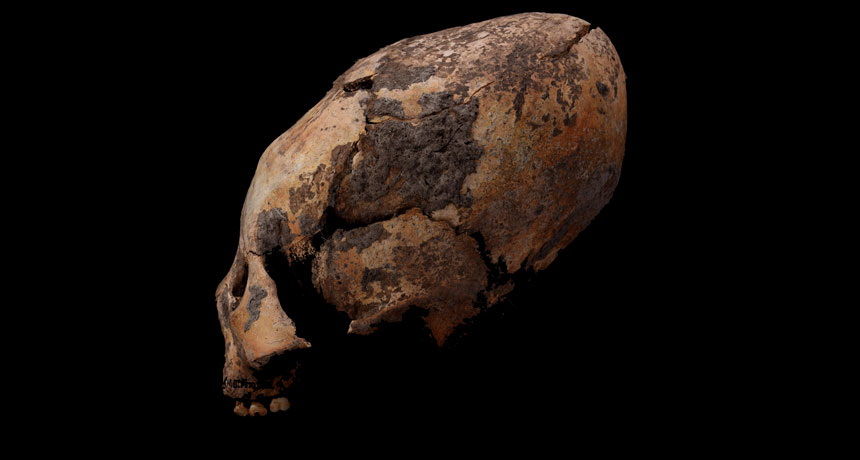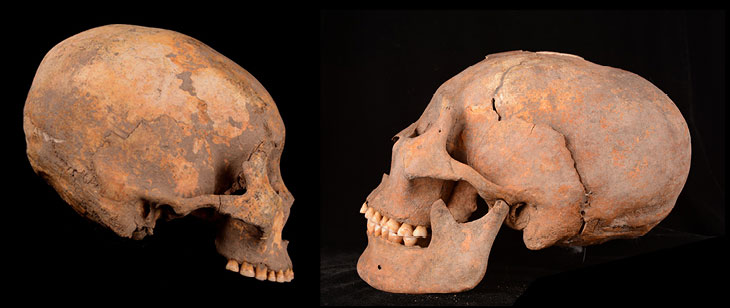East Asians may have been reshaping their skulls 12,000 years ago
Fossils expand the known distribution of the ancient practice beyond Europe and Central Asia

STRETCH MARKS Oddly shaped human skulls discovered in northeastern China, including this approximately 6,000-year-old example from a child, point to millennia of intentional cranial reshaping in East Asia, researchers say.
Q. Wang
Ancient tombs in China have produced what may be some of the oldest known human skulls to be intentionally reshaped.
At a site called Houtaomuga, scientists unearthed 25 skeletons dating to between around 12,000 years ago and 5,000 years ago. Of those, 11 featured skulls with artificially elongated braincases and flattened bones at the front and back of the head, says a team led by bioarchaeologist Quanchao Zhang and paleoanthropologist Qian Wang.
Skull modification occurred over a longer stretch of time at the site than at any other archaeological dig, the researchers report online June 25 in the American Journal of Physical Anthropology.
Permanent reshaping of a skull early in life, when cranial bones are soft, can be achieved by compressing an infant’s head with one’s hands. Binding the head with hard, flat surfaces such as boards or tightly wrapping the head in cloth similarly remodels immature cranial bones. Specific head modifications may have been used as signs of social status.
Oddly shaped, intentionally modified skulls have been found in many parts of the world. Claims from the 1980s that two roughly 45,000-year-old Neandertal skulls had been reshaped early in life have been dismissed by many researchers. The earliest skulls with generally accepted signs of cranial modification date to between around 13,000 and 10,000 years ago in western Asia, southeastern Australia and now, East Asia. In the Americas, this practice began more than 8,000 years ago (SN Online: 2/13/18).
“It is too early to tell whether intentional cranial modification first emerged in East Asia and spread elsewhere or originated independently in different places,” says Wang, of Texas A&M University in Dallas.
Houtaomuga was excavated from 2011 to 2015. A man’s skeleton with a modified skull was found in a tomb dating to between 13,000 and 11,000 years ago, based on styles of pottery found in the same sediment layer. Radiocarbon dating of the skeleton placed it at around 12,000 years old. Two sediment layers dating to between 6,300 and 5,000 years old contained 10 skeletons with reshaped skulls.

Of five modified adult skulls, four came from men and one from a woman. Estimated ages at death for the 11 Houtaomuga individuals range from around 3 to 40.
Signs of skull reshaping as a practice reserved for high-status individuals or certain families appeared at the site, Zhang, of Jilin University in Changchun, China, Wang and colleagues report. A 3-year-old child with a reshaped braincase was buried with large amounts of pottery and other artifacts, suggesting the youngster came from a rich family. Numerous shell ornaments placed on a woman with an elongated skull likely denoted her high status. And an adult and adolescent with modified skulls were buried together, suggesting that the two may have come from the same family.
While those individuals clearly had modified skulls, the oldest Houtaomuga skull displays a slightly elongated braincase that probably wasn’t intentionally modified, says paleoanthropologist Xijun Ni of the Chinese Academy of Sciences in Beijing. That cranial shape characterizes some Asians today, Ni contends. The tops of such skulls often include a slight depression near the back, as on the 12,000-year-old Houtaomuga skull, he adds.
Solid evidence of cranial reshaping at Houtaomuga goes back only about 6,000 years, Ni says. But Wang disagrees. The extent of bone flattening on the 12,000-year-old Houtaomuga braincase exceeds any naturally occurring variations in skull shape, Wang argues.
A human skull discovered by workers at an underwater sand mine in northeastern China displays intentionally flattened bones at the front and back of the braincase, a team led by Ni reported January 26 at bioRxiv.org. Radiocarbon dating puts that skull between 11,245 and 11,200 years old.
Chinese findings have expanded the known distribution of ancient skull reshaping beyond Europe and Central Asia, says archaeologist Maria Mednikova of the Russian Academy of Sciences in Moscow. Unlike Ni, Mednikova regards the 12,000-year-old Houtaomuga skull as having been intentionally remodeled. “The new report on cranial deformations in China draws a picture of an entrenched tradition that continued for millennia,” she says.







